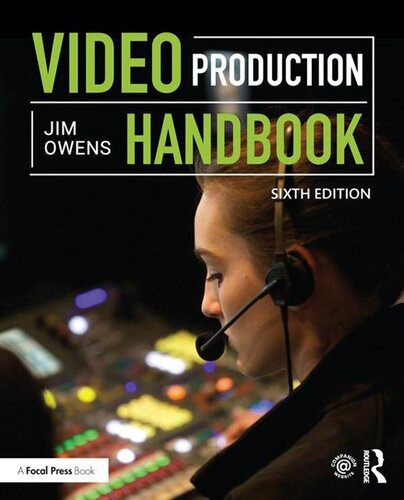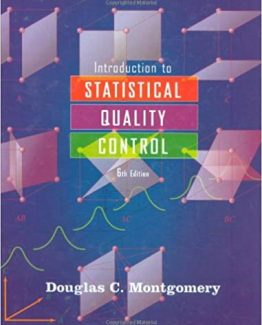Video Production Handbook 6th Edition by Jim Owens, ISBN-13: 978-1138693494
[PDF eBook eTextbook]
- Publisher: Routledge; 6th edition (March 1, 2017)
- Language: English
- 326 pages
- ISBN-10: 1138693499
- ISBN-13: 978-1138693494
This new edition of the Video Production Handbook walks students through the full video production process, from inception of idea to final distribution. Concentrating on the techniques and concepts behind the latest equipment, this book demonstrates the fundamental principles needed to create good video content on any kind of budget. Ideal for students, the new edition features a new chapter on directing and updated information on the latest DSLR and cinema cameras, LED lighting and much more. A companion website with additional resources for professors rounds out this full-color, highly visual text to meet all of your video production learning needs.
Table of Contents:
Cover
Half Title
Title Page
Copyright Page
Table of Contents
Acknowledgments
Introduction
Chapter 1 Overview of Video Production
1.1 What Is Video Production?
1.2 Defining the New Media
1.3 Understanding the Field of Video Production
1.4 Remember the Purpose
1.5 Is There a Right Way?
1.6 The Production Approach
1.7 Equipment
1.8 It’s Designed for You
1.9 Learning Basics
1.10 What Equipment Is Needed?
1.11 Equipment Performance
Interview: Ben Brown, Media Executive
Chapter 2 Production Crew
2.1 Production Crew Size
Video Production Crew Job Descriptions ….
2.2 Producer
2.3 Assistant Producer or Associate Producer
2.4 Director
2.5 Assistant Director or Associate Director
2.6 Production Assistant
2.7 Floor Manager or Stage Manager
2.8 Technical Director or Vision Mixer
2.9 Makeup Artist
2.10 Graphic Designer/Operator
2.11 Lighting Director/Vision Supervisor
2.12 Videographer/Camera Operator/Photographer
2.13 Camera Assistant
2.14 Audio Mixer/Sound Mixer/Sound Supervisor
2.15 Boom Operator or Audio Assistant
2.16 Engineer
2.17 Writer
2.18 Editor
2.19 Set Designer
Professional Crew
2.20 Freelance Crew
2.21 Below-the-Line/Above-the-Line
2.22 The Structure of a Video Production Crew
2.23 What Do You Wear?
2.24 What Do You Bring with You?
Interview: Tommy Mitchell, Crewer
Chapter 3 Organizing the Production
3.1 Art Conceals Craft
3.2 Shot Selection
3.3 The Problem of Familiarity
3.4 The Issue of Quality
3.5 “Bigger and Better”
The Production Process
3.6 It All Starts with an Idea (Concept)
3.7 Goals and Objectives
3.8 Determining Your Audience
3.9 Research
3.10 Covering the Subject
3.11 Production Methods
3.12 The Empirical Approach
3.13 The Planned Approach
3.14 Storyboards
3.15 Why Plan?
3.16 The Three Stages of Production
3.17 Coverage
3.18 Building a Production Outline
3.19 Broad Treatment
3.20 Production Research
3.21 Remote Surveys (Recce)
3.22 Freedom to Plan
3.23 Single-Camera Shooting
3.24 Multicamera Shooting
3.25 Budgeting
3.26 Copyrights
3.27 Contracts
Interview: DT Slouffman, Producer
Chapter 4 Production Techniques
4.1 Single- and Multicamera Production
4.2 Multicamera ISO
4.3 Multicamera Production Without a Switcher
4.4 The Illusion of Reality
4.5 The Camera’s Role
4.6 The Camera as an Observer
4.7 The Persuasive Camera
4.8 How Do You Visualize Something That Does Not Exist? .
Interview: Scott Rogers, Sports Producer
Chapter 5 Writing for Video
5.1 The Script’s Purpose
5.2 The Outline Script
5.3 Basic Script Formats
5.4 The Full Script
5.5 The Drama Script
Suggestions on Scriptwriting
5.6 Visual Storytelling
5.7 Style
5.8 Script Processes
5.9 Scriptwriting Basics
5.10 Script Questions
Interview: Robyn Sjogren, Writer
Chapter 6 Directing
6.1 The Director
6.2 Selective Techniques
6.3 Communication
6.4 Guiding the Viewer Through the Scene
6.5 Organizing the Angles
6.6 Visual Variety
6.7 Focusing Audience Attention
6.8 Shooting Controlled Action
6.9 Segmented Shooting with a Single Camera
6.10 Multicamera Techniques
6.11 Directing Talent
Interview: Doug Smart, Director
Chapter 7 The Camera
7.1 A Variety of Cameras
7.2 Cameracraft
Camera Features
7.3 Main Camera Features
7.4 Lenses
7.5 Focal Length and Lens Angle
7.6 The Prime lens or Fixed Lens
7.7 The Zoom Lens
7.8 The Aperture of the Lens
7.9 Lens Accessories
7.10 The Image Sensor
7.11 Gain: Sensor Sensitivity
7.12 The Viewfinder
7.13 Audio
Controlling the Camera
7.14 Handling the Camera
7.15 Supporting the Camera
7.16 Handheld Cameras
7.17 The Pan Head (Panning Head or Tripod Head)…
7.18 Using a Tripod
7.19 The Monopod
7.20 Jib Arms
7.21 Camera Slider
7.22 Specialty Camera Mounts
7.23 Camera Care
Interview: Keith Brown, Videographer
Chapter 8 Using the Camera
8.1 Just Point and Shoot
8.2 Shooting For the Screen
8.3 What Is the Best Shot?
8.4 Why Move the Camera?
8.5 Focusing
8.6 Depth of Field
8.7 Using Focus to Communicate
8.8 Focus Issues?
Exposure
8.9 What Is “Exposure”?
8.10 Underexposure and Overexposure
8.11 Automatic Exposure
8.12 Exposure: Graduated Filters
8.13 Crossing the Line
The Moving Camera
8.14 Following Moving Subjects
8.15 Framing Movement .
Camera Moves
8.16 Moving Camera Mounts
8.17 Walking
8.18 Shooting from Vehicles
The Basics of Shooting
8.19 Selecting the Right Shots
8.20 Persuasive Shots
Composing Pictures
8.21 Composition Rules and Guidelines
8.22 Shots That Are Different
8.23 Watch the Background
8.24 The Rule of Thirds
8.25 Shooting from Different Angles
8.26 Showing Scale
8.27 Framing the Subject
8.28 Leading Lines
8.29 Headroom
8.30 Changing the Perspective
8.31 Distortions
Lens Filters
8.32 What Does a Filter Do?
Anticipating Editing
8.33 Continuity
8.34 Shooting to Improve Editing
Interview: Nathan White: Videographer
Chapter 9 Shooting People and Objects
Shooting People
9.1 The Single Person
9.2 Arranging People Shots
9.3 Effective Shots
9.4 Selecting the Right Shot
9.5 Single-Camera Interviews
9.6 Editing Continuous Interviews
9.7 Shooting Groups
9.8 Car Interviews
9.9 Walking Interviews
Shooting Instructional Productions
9.10 Typical Instructional Productions
9.11 Approaches to Instruction
9.12 Advance Planning
9.13 Creating the Instructional Program
9.14 Shooting Objects
Interview: Sarah Hogencamp, Director/Videographer.
Chapter 10 Working with the Talent
10.1 Talent
10.2 Talent and Production Styles
10.3 The Interview: Go Beyond the Obvious
10.4 Selecting Talent
10.5 Inexperienced Talent
The Actor’s Craft
10.6 The Host
10.7 The Off-Camera Host
10.8 Presenting the Information
10.9 Importance of People in the Scene
10.10 Safety
Interview: Kristin Ross Lauterbach, Director
Chapter 11 Audio for Video
11.1 The Essential Component
11.2 The Nature of Sound
11.3 Acoustics
11.4 Mono Sound
11.5 Stereo Sound
11.6 Surround Sound
Microphones
11.7 It Begins with the Microphone
11.8 Directional Features
11.9 Dynamic and Condenser Microphones
Types Of Microphones
11.10 Camera Microphones
11.11 The Handheld Microphone
11.12 The Shotgun Microphone
11.13 Lavalier (Lapel or Clip-on Mic) Microphones
11.14 Boundary or PZM Microphone
11.15 Hanging Microphone
11.16 Surround Sound Microphone
11.17 Wireless Microphone
11.18 Hidden Mics
11.19 Microphone Stands and Mounts
Controlling Audio
11.20 Automatic Gain Control (AGC) for Audio
11.21 Manual Control
11.22 Monitoring the Audio
11.23 The Audio Mixer
11.24 Using the Audio Mixer
11.25 Preparing for Audio
Production Sounds
11.26 Natural Sound
11.27 Program Music
11.28 Sound Effects
Interview: Noel Dannemiller, Sound Mixer
Chapter 12 Lighting for Video
12.1 Lighting the Scene
12.2 Lighting Options
12.3 Existing Light
12.4 The Camera Does Not Compensate
12.5 The Key Factors
12.6 If There Is Not Enough Light
12.7 If There Is Too Much Light
12.8 The LED Light
12.9 The Spotlight (Hard Light)
12.10 The Floodlight (Soft Light)
12.11 Lighting Contrast
12.12 Three-Point Lighting
12.13 Color Temperature Compensation
12.14 Shooting in Daylight
12.15 Using Reflectors
12.16 Bounce Light
Lightweight Light Supports
12.17 Grip Clamps
12.18 Light Stands
Lighting Instruments
12.19 Camera Light
12.20 Soft Light Panel
12.21 Cyc Lights
12.22 Fresnel Spotlights
12.23 Small Portable Spotlights
12.24 Flexible Mat Lighting
Interview: Tommy Brown, Lighting
Chapter 13 The Background
13.1 The Importance of the Background
13.2 Real and Unreal Backgrounds
13.3 Set Components
13.4 The Neutral Background
13.5 Economical Sets
13.6 Semipermanent Sets
13.7 Chroma-Key Sets
13.8 Virtual Sets
13.9 Outside/Back-Lot Sets
13.10 The Location
13.11 Watch the Background
13.12 Foreground Pieces
13.13 Versions of “Reality”
13.14 What Can We Do About the Background?
13.15 Rearranging the Background
13.16 Partial Settings
13.17 Typical Examples of Partial Settings
13.18 Facing Reality
Interview: John DeCuir, Jr., Production Designer.
Chapter 14 Television Graphics
14.1 The Goals of Television Graphics
14.2 Types of Graphics
14.3 Designing Television Graphics
14.4 Animated Graphics
14.5 Backgrounds for Graphics
14.6 Graphics Equipment
Interview: Lou Moore, Television Graphics Operator ..
Chapter 15 Recording the Video
The Video Image
15.1 High-Definition Television (HDTV or HD)
15.2 4K Television
15.3 8K Television
Video Recording Media
15.4 Videotape
15.5 Flash Memory
15.6 Hard Disk Drive (HDD) (Internal Hard Drive)
15.7 External Camera Hard Drives
15.8 Hard Drive Server Recorders
15.9 XDCAM Disk
15.10 Recording Media Care
15.11 Video Recording Suggestions
Interview: Ryan Hammer, Atlas Digital
Chapter 16 Editing
16.1 Editing Goals
16.2 Shooting Order versus Running Order
16.3 Editing Video and Audio
16.4 Logging
16.5 An Overview of the Nonlinear Process
16.6 Editing Equipment
16.7 Organization
Editing the Project
16.8 Editing Begins
16.9 Selecting the Shots
16.10 The Order of Shots
16.11 Where Should the Edits Be Made?
16.12 Transitions
16.13 Continuity
16.14 Good Editing Techniques
16.15 Anticipating Editing
Interview: Brock Smith, Editor
Chapter 17 Distributing Your Production
17.1 Traditional Broadcast Distribution
17.2 Distributing Hard Copies of the Production
17.3 Online Distribution
17.4 Live Online Distribution
17.5 Internet Protocol Television (IPTV)
17.6 3G/4G Transmission
17.7 Festivals and Competitions
Interview: Chad Crouch: CEO, The Creative Group….
Glossary
Index
Jim Owens has worked and taught in the video and television industry for over 30 years. As an Emmy Award-winning producer, he has worked on local, regional, and national productions. Owens’ international television work has included 14 Olympic broadcasts and has taken him to over 25 countries. He is the author of the Video Production Handbook, Television Production, and Television Sports Production, and has had over 30 articles published in television and broadcast magazines in the United States and Europe. He also served as the curator of the History of Olympic Broadcasting exhibit at the Olympic Museum in Lausanne, Switzerland. Owens is Dean of the School of Communication Arts at Asbury University in Wilmore, Kentucky, where he has taught since 1981.
What makes us different?
• Instant Download
• Always Competitive Pricing
• 100% Privacy
• FREE Sample Available
• 24-7 LIVE Customer Support





